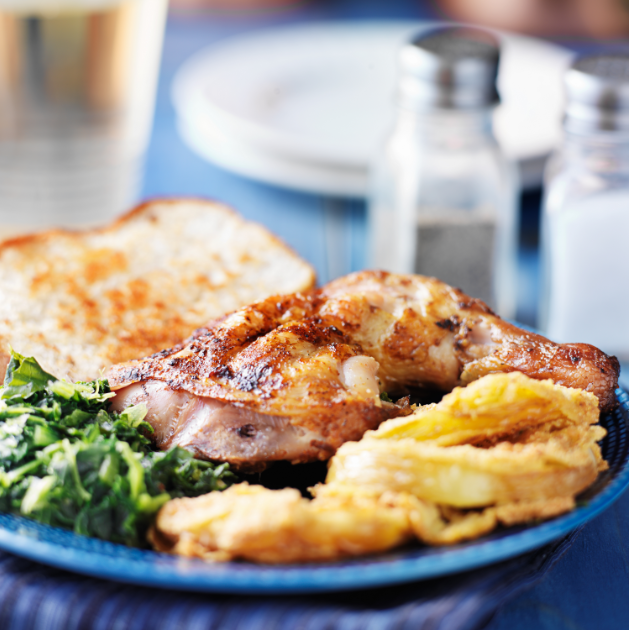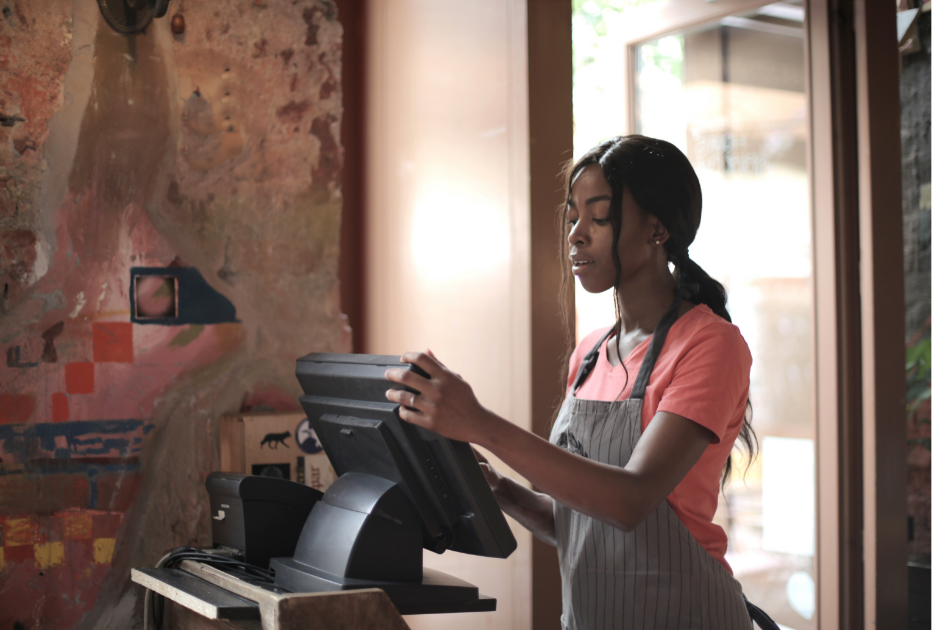Immigrants are in the spotlight lately. And not in the good, Patti LuPone/Audra McDonald duet kind of way.
LuPone (left) and McDonald (right). Photo by Drama League/Flickr.
As promised, the Trump administration is advancing its plans to boot millions of immigrants from the United States — and reviving its order to stop them from coming here in the first place.
To hear all your Sean Spicers, your Stephen Millers, and your Kellyanne Conways tell it, the measures are necessary to stop, well, pretty much everything bad currently happening in America — from job-stealing to crime to terrorism.
Convincing Americans that immigrants are more than the sum of their worst stereotypes means winning back some hearts and minds, but these days, it can feel futile to appeal to America's heart or its brain.
But perhaps — perhaps America's stomach is still willing to listen.
Immigrants don't only make America great; they make it delicious. The people who risk their livelihoods and occasionally their lives to come here are often more than happy to share their secret recipes with us. Without them, we'd have nothing to eat ... nothing good, anyway.
Here are 17 of the top contributions to America's culinary scene by refugees, ex-pats, and immigrants.
Try not to drool on the keypad.
1. You wouldn't know about pretty much all the Chinese food you like if it weren't for refugee-turned-immigrant-turned-master chef Cecilia Chiang.
Chang and kung pao chicken. Photos by John Parra/Getty Images and Sodanie Chea/Flickr.
Chiang, who survived the Japanese invasion of China before immigrating to San Francisco in the 1960s, introduced America to the delicious, umami, stir-fried meat pile known as kung pao chicken at her restaurant, the Mandarin.
2. This giant paella wouldn't exist if chef Michael Mina hadn't moved here from Egypt.
Mina, the guy with the oar, was born in Cairo, immigrated to the U.S. and settled in Washington state, proceeded to open over a dozen restaurants in cities across the country, win a Michelin star, write a cookbook, appear on Gordon Ramsey's "Hell's Kitchen," launch a media company, and, in this photo, somehow managed to combine rice, shellfish, and nautical equipment into something so appetizing you would probably win a free T-shirt for finishing it.
3. Without lax 19th century immigration laws, America would have been denied its birthright: the Bud Light Straw-ber-Rita.
Anyone who watched this year's Super Bowl just for the commercials knows that Adolphus Busch was a hardscrabble German immigrant who trudged through miles of mud and ominously high grass to found the all-American beer company that makes the U.S. the perennial world leader in drunken high school reunion softball games.
4. You'd have to travel to an Eastern European war zone to enjoy these perogis.
Photo by Veselka/Facebook.
In 1954, Ukrainian refugees Wolodymyr and Olha Darmochawal came to New York City and founded Veselka in the East Village, serving these soul-altering fried meat, cheese, and potato pouches by the crock-load to NYU students who have crushed one too many Bud Light Lime Straw-ber-Ritas.
5. This ridiculous pulled turkey burger with Indian spices, candied bacon, and masala fries wouldn't be available in Elvis country.
Maneet Chauhan and the turkey burger. Photos by Theo Wargo/Getty Images and Chauhan Ale and Masala House/Facebook.
One great thing about being alive in 2017 is that you can find South Asian-Southern fusion sandwiches for less than $20 in the middle of the Bible Belt like it's no big deal thanks to immigrants like Indian-American chef Maneet Chauhan (you might know her as a frequent judge on "Chopped"), who opened Chauhan Ale and Masala House in Nashville in 2014.
6. We wouldn't know the gastronomic perfection that is surf and turf served over two cheese enchiladas.
Richard Sandoval and surf and turf. Photos by Neilson Barnard/Getty Images and La Hacienda/Facebook.
Before Richard Sandoval was a "Top Chef Masters" contestant, Bon Apetit Restaurateur-of-the-Year Award winner, and international food star, he was just a Mexico City kid with a dream. That dream? To put fried onions on top of steak on top of enchiladas with some lobster tail and risotto getting freaky on the side, as his La Hacienda in Scottsdale, Arizona, did on Valentine's Day 2017.
7. Anything with Huy Fong sriracha in it would have to be seasoned with a far lesser hot sauce.
Photo by Steven Depolo/Flickr.
Thanks to erstwhile humane values of decades past, America's hottest condiment was given unto us by a refugee — David Tran — who fled his native Vietnam on the ship Huy Fong in the 1970s. Had he come four-and-a-half decades later, it's likely he would have wound up in Canada and invented spicy maple syrup or whatever. (Actually, to be honest, that sounds pretty great. Please, immigrants from tropical climes living in Canada, invent spicy maple syrup.)
8. The Swedes might have chef Marcus Samuelsson's La Isla Bonita all to themselves.
Samuelsson and La Isla Bonita. Photos by Gustavo Caballero/Getty Images and Red Rooster Harlem/Facebook.
With all the problems in Sweden that are totally so real that everyone knows about them, it's no wonder that Samuelsson (who was born in Ethiopia and is another frequent "Chopped" judge) skipped town for New York City, bringing his brand of soul food to Harlem's Red Rooster — including this otherworldy mashup of tres leches cake, rum, passion fruit, and banana.
9. Detroit would be bereft without its iconic chili-onion-mustard dogs.
Photo by Steven Depolo/Flickr.
The precise origin of the Michigan-favorite Coney dog has been debated for decades, but pretty much no one contests that it was invented by Greek immigrants, notably brothers Bill and Gust Keros around 1919, when they discovered — after millennia of flailing by the best chefs in the world — that the ideal condiment for meat was goopier meat.
10. You wouldn't even be able to dream about Jose Andres' ibérico bacon cristal bread uni.
Jose Andres (L) and tapas (R). Photo by Larry French/Getty Images; Jaleo/Facebook.
It's also known as coca con arizos de mar — or "expensive ham 'n fish pizza" — and Andres serves this magical creation at his D.C. tapas restaurant Jaleo. The award-winning chef, who hails from Spain, was one of several dozen who closed his restaurants on Feb. 16, 2017, in protest of the Trump administration's immigration policies.
11. Vending machines, bodegas, and gas station convenience stores nationwide would be thousands of dollars poorer without Flamin' Hot Cheetos on the shelves.
Photo by Calgary Reviews/Flickr.
More than "The Great Gatsby," more than "Rudy," even more than Katy Perry's "Roar," the story of Flamin' Hot Cheetos is the story of the American dream. Working full time as a janitor at a Cheetos factory (!), Mexican immigrant Richard Montañez took home some defective, un-dusted Cheetos after an equipment breakdown, sprinkled some chili spices on them, and presented his creation to corporate bigwigs, who promptly put them into production. The tangy corn tubelettes quickly became the company's #1 selling snack, and Montañez was promoted to executive vice present of multicultural sales and community activation, having successfully pulled himself up by his sticky-dusty bootsraps.
12. Cronuts would not be a thing.
Dominique Ansel and a cronut. Photos by Noam Galai/Getty Images and Chun Yip So/Flickr.
Assuming you could get a cronut, you would be first-born-child-level indebted to Dominique Ansel, the French-born chef who debuted the monstrously scrumptious croissant-donut hybrid in New York City in 2013. Unfortunately, four years later, you still can't get a cronut.
13. Your airport layover would be 1,000% less tolerable without this margherita pizza from Wolfgang Puck Express.
Puck and pizza. Photos by Michael Kovac/Getty Images and Jeff Christiansen/Flickr.
Stuck in Downtown Disney World or delayed getting back to Milwaukee? You could do a lot worse than this gorgeous bubbly cheese pie by Puck, Austria's greatest gift to America since the toaster strudel.
14. You'd have to eat this mouthwatering soft-serve in a cup instead of a cone.
Photo by Mark Buckawicki/Wikimedia Commons.
If there's one thing certain cable news outlets will never fail to remind you, it's that Syrian immigrants are very, very, super-duper scary. Perhaps nothing in history illustrates this better than their most terrifying invention to date, the ice cream cone. The edible frozen treat vessel was created by Abe Doumar, who debuted his creation at the St. Louis Exposition in 1904, the culmination of the Middle Eastern migrant's dastardly plot to improve mankind and delight children of all ages around the world forever and always.
It's not just that immigrants invent food we like to eat. They pretty much cook everything we eat too.
Roughly 20% of restaurant cooks are undocumented, and an even greater share are foreign-born — up to 75% in some cities. That means that immigrants are responsible for feeding you even the down-home comfort food you enjoy, including...
15. This cheeseburger from Hardee's...
Photo by Mr. Gray/Flickr.
16. ...this stock photo apple pie....
Photo by mali maeder/Pexels.
17. ...and this American flag sheet cake.
Photo by Eugene Kim/Flickr.
Immigrants deserve a place in America. And not just because they fill our tummies with tasty victuals.
They enrich our communities and keep our culture varied and interesting. They do the jobs most of us don't want to do. They pay hundreds of billions of dollars in taxes and contribute to our economy in countless measurable and immeasurable ways.
Immigrants and refugees don't come here to get Americans fired, steal our wallets, or blow us up. Most of them come here for a better, safer, more secure life.
They make all of our lives richer — and more delicious — in the process.




 Beaver on riverbank.
Beaver on riverbank.  Pbs Nature Swimming GIF by Nature on PBS
Pbs Nature Swimming GIF by Nature on PBS  An actual beaver dam on the now-thriving Price River
An actual beaver dam on the now-thriving Price River 
 Who doesn't love Pluto?
Who doesn't love Pluto?  Pluto agrees.
Pluto agrees. 
 a piece of paper with a heart drawn on it Photo by
a piece of paper with a heart drawn on it Photo by 
 "Bought an espresso machine, took some time to learn how to dial it in and pull a proper shot."
"Bought an espresso machine, took some time to learn how to dial it in and pull a proper shot." "Frozen meals are just as unhealthy, but much cheaper."
"Frozen meals are just as unhealthy, but much cheaper." "I’ve embraced the gray!"
"I’ve embraced the gray!"  "Bidet toilet seat is cheap, easy to install, much easier and faster to use."
"Bidet toilet seat is cheap, easy to install, much easier and faster to use."
 American portion sizes are colossal.Canva Photos
American portion sizes are colossal.Canva Photos American public restrooms aren't very private.Canva Photos
American public restrooms aren't very private.Canva Photos Cashiers in America stand all shift long.Canva Photos
Cashiers in America stand all shift long.Canva Photos America loves the Pledge of Allegiance.Canva Photos.
America loves the Pledge of Allegiance.Canva Photos. Cosmetic surgeries on pets are...a choice.Canva Photos.
Cosmetic surgeries on pets are...a choice.Canva Photos. America loves extra sugar in savory foods.Canva Photos.
America loves extra sugar in savory foods.Canva Photos.